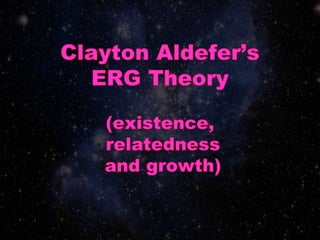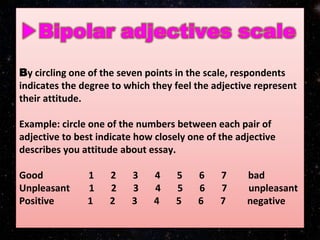Affective Assessment
- 2. • Affective Assessment is an assessment based on the student’s attitudes, interest and values.
- 3. Bloom's Taxonomy of Learning Domains Bloom's Taxonomy was created in 1956 under the leadership of educational psychologist Dr. Benjamin Bloom in order to promote higher forms of thinking in education, such as analysing and evaluating, rather than just remembering facts (rote learning).Learning takes place in 3 domains: • Cognitive • Psychomotor • Affective
- 4. Affective Domain The Affective Taxonomy, which describes objectives that reflects underlying emotions, feelings, or values rather than cognitive or thought complexity. This taxonomy describes a process by which another person’s, groups, or society’s ideas, beliefs, customs, philosophies, attitudes, and so on are gradually accepted and internalized by a different person, group, or society. This process usually begins with a minimal, partial, or incomplete acceptance of an alternative point of view and culminates with the complete integration of this point of view into an individual’s personal belief system.
- 5. For example: An individual who naively believed in early 1985 that the return of Halley’s Comet in 1986 would cause the end of life on Earth may at first have found it difficult even listen to, receive, or attend to information that indicated that the comet’s return would have no significant or lasting effect on life on Earth. Instead, the individual may have ignored such information, attempting instead to convince others of Earth’s impending doom. However, with the passage of time throughout the year, and with increased media and educational reports about the event, the individual may have increasingly listened to such information and even considered, discussed, or responded to explanations regarding Earth’s safety owing to the comet’s distance from Earth, its lack of mass, the protection afforded by Earth’s atmosphere, etc. Eventually the individual likely began to value the argument that the comet would have little or no effect on life on Earth and ceased preaching the demise of Earth.
- 6. Level and Definition Illustrative Verbs Example Receiving refers to the student's willingness to attend to particular phenomena of stimuli (classroom activities, textbook, music, etc.). asks, chooses, describes, follows, gives, holds, identifies, locates, names, points to, selects, sits erect, replies, uses Listening to discussions of controversial issues with an open mind. Responding refers to active participation on the part of the student. At this level he or she not only attends to a particular phenomenon but also reacts to it in some way. answers, assists, complies, conforms, discusses, greets, helps, labels, performs, practices, presents, reads, recites, reports, selects, tells, writes Participating in team problem solving activities. Questions new ideals, concepts, models, etc. in order to fully understand them. Valuing is concerned with the worth or value a student attaches to a particular completes, describes, differentiates, Accepting the idea that integrated curricula is a good way
- 7. Organization is concerned with bringing together different values, resolving conflicts between them, and beginning the building of an internally consistent value system. adheres, alters, arranges, combines, compares, completes, defends, explains, generalizes, identifies, integrates, modifies, orders, organizes, prepares, relates, synthesizes Recognizing own abilities, limitations, and values and developing realistic aspirations. Accepts responsibility from one’s behavior. Characterization by a value or value set. The individual has a value system that has controlled his or her behavior for a sufficiently long time for him or her to develop a characteristic “life-style.” acts, discriminates, displays, influences, listens, modifies, performs, practices, proposes, qualifies, questions, revises, serves, solves, uses, verifies A person's lifestyle influences reactions to many different kinds of situations. Shows self-reliance when working independently. Uses an objective approach in problem solving. .
- 8. ▶Certain positive values needs to be introduced to our students through the various academic subjects. For instance, a mathematics teacher can developed and still the value of “self-discipline”, of honesty, and integrity in his lessons. It is well-known that mathematics, apart from its utilitarian function, develops disciplined minds and forces the students to think logically. A way to do this would be to study the lives of great mathematicians whose works inspire the students.
- 9. ▶There is an on-going debate among educators today about the relative importance of developing a child’s IQ or Intelligence Quotient as opposed to developing his “EQ or Emotional Quotient”. Research shown that, those with fully developed “EQ’s” tended to be more successful, better able to adjust to his environment, and contribute more positively to the society.
- 10. ▶Affective learning competencies are often stated in the form of instructional objectives. Affective Learning Competencies
- 11. These are the specific statements of learner behaviour or outcomes that are expected to be exhibited by students after completing a unit of instruction. A unit of instruction may, for example mean: a six-week lesson on Filipino culture a one-week lesson on algebraic expression a class period on “subtracting with borrowing”
- 12. a.Behavioural objective- specifies an observable, measureable behavior to be exhibited, the conditions under which is to be exhibited, and the criterion for mastery. b.Expressive objective- specifies an educational activity but does not specify the particular outcome of the activity.
- 13. Unfortunately, they are not always well-written and do not always fit a particular class of style. Instructional objectives often have to be formulated by classroom teachers to fit their individual classrooms. Example: By Friday, the student will be able to recite the names of the months in order. Instructional objectives are specific, measurable, short- term, observable student behaviors Objectives are the foundation upon which you can build lessons and assessments that you can prove meet your over-all course or lesson goals.
- 14. The purpose of objectives is to ensure that learning is focused clearly enough that both students and teachers know what is going on, and so learning can be objectively measured. Think of objectives as tools used to make sure you reach your goals; arrows you shoot towards your target (goal).
- 15. Focal concepts in Affective Domain - The word attitude (from Latin aptus) is defined within the framework of social psychology as a subjective or mental preparation for action. - Attitudes are defined as a mental predisposition to act that is expressed by evaluating a particular entity with some degree of favor or disfavor.
- 16. ▶Cognitions - cognitions are our beliefs, theories, expectations, cause-and-effect beliefs, perceptions relative to the focal point; statement of beliefs and expectations which vary from one individual to the next. ▶Affect – refers to feelings with respect to the focal object – fear, liking, anger ▶Behavioral Intentions – refers to our goals, aspirations, and our expected responses to the attitude object. ▶Evaluation – often considered the central component of attitudes; it consists of the imputation of some degree of goodness or badness to an attitude object.
- 17. Predisposition and Attitude •Predisposition is an inclination beforehand to interpret statements in a particular way while attitude is a complex mental state involving beliefs and feelings and values and dispositions to act in certain ways. Why study attitudes? •Attitude can influence the way we act and think in the social communities we belong. They can function as frameworks and references for forming conclusions and interpreting or acting for or against an individual; individuals, a concept or an idea.
- 18. - It is a reason or set of reasons for engaging in a particular behavior. The reasons include basic needs, or an object, goal, state of being or ideal that is desirable.
- 19. “Motivation and desire represent the very foundation of learning. If students don’t want to learn, there will be no learning. If they feel unable to learn, there will be no learning. Desire and motivation are not academic achievement characteristics. They are affective characteristics.” (Stiggins, 2005, pp. 199‐200)
- 23. - Needs are arranged in order of importance, from basic to complex. - Human needs have wants and desires which influence behavior: only unsatisfied needs can influence behavior, satisfied needs cannot. - The person advances to the next level of needs only after the lower need is at least minimally satisfied. - The further the progress up the hierarchy, the more individuality, humanness and psychological health a person will show.
- 25. - It is sometimes called “Motivator-Hygiene Theory”. •Motivators – challenging work, recognition, responsibility, which give positive satisfaction •Hygiene factors – status, job security, salary and fringe benefits – do not motivate if present, but if absent will result in demotivation.
- 27. •This theory posits that there are three groups of core needs—existence, relatedness, and growth—hence the label: ERG theory. •The existence group is concerned with providing our basic material existence requirements. •The second group of needs are those of relatedness, the desire we have for maintaining important interpersonal relationships. •These social and status desires require interaction with others if they are to be satisfied, and they align with Maslow's social need and the external component of Maslow's esteem classification.
- 28. - It can direct behavior toward particular goals - lead to increase effort and energy; increase initiation of, and persistence in activities - enhance cognitive processing - determine what consequences are reinforcing - lead to improve performance Motivation in education can have several effects on how students learn and their behavior towards subject matter.
- 29. occurs when people are internally motivated to do something because it either brings them pleasure, they think it is important, or they feel that what they are learning is morally significant which comes when a student compelled to do something because of factors external to him or her like money or good grades.
- 30. •Self-efficacy is an impression that one is capable of performing in a certain manner or attaining certain goals. It is a belief that one has the capabilities to execute the courses of actions required to manage prospective situations
- 31. Self-esteem relates to a person’s sense of self- worth while, self-efficacy relates to person’s perception of their ability to reach a goal.
- 33. This the most common measurement tool in the affective domain. It essentially requires an individual to provide an account of his attitude or feelings toward a concept or idea or people. It is also called “written reflections”.
- 34. It refers to a set of categories designed to elicit information about a quantitative attribute in social science.
- 35. Example:
- 36. It tries to assess an individual’s reaction to specific words, ideas or concepts in terms of ratings on bipolar scales defined with contrasting adjectives at each end. Example: Good ___ ___ ___ ___ ___ ___ ___ Bad 3 2 1 0 1 2 3 (3 – extreme; 2 – quite; 0 - neutral)
- 37. A number of basic considerations are involved in SD methodology. a. Bipolar adjectives are a simple, economical means for obtaining data on people’s reactions. b. Ratings on bipolar adjective scales tend to be correlated, and three basic dimensions of response account for most of the co- variation in ratings. c. Some adjective scales are almost pure measures of the EPA dimensions: good-bad (Evaluation), powerful-powerless (Potency), and fast-slow (Activity). d. EPA measurements are appropriate when one is interested in an effective domain responses.
- 38. Thurstone is considered the father of attitude measurement and addressed the issue of how favorable an individual is with regard to a given issue. He developed an attitude continuum to determine the position of favorability on the issue.
- 39. Attitude towards Black people in America Example: Directions: put a check mark in the blank if you agree with the item. 1. Blacks should be considered the lowest class of human beings. (0.9) 2. Blacks and whites must be kept apart in all social affairs where they might be taken as equals. (3.2) 3. I am not interested in how blacks rate socially. (5.4) 4. A refusal to accept blacks is not based on any fact of nature, but on a prejudice which should be overcome. (7.9) 5. I believe that blacks deserve the same social privileges as whites. (10.3)
- 40. In 1932,Rensis Likert developed the method of summated ratings (or Likert scale), which is widely used. This requires an individual to tick on a box to report whether they “strongly agree” “agree” “undecided”, “disagree” or “strongly disagree” in response to a large number of items concerning attitude object or stimulus.
- 41. Likert scale is derived as follows: a. Pick individual items to include. Choose individual items that you know correlate highly with the total score across items. b. Choose how to scale each item, or construct labels for each scale value to represent interpretation to be assigned to the number. c. Ask your target audience to mark each item. d. Derive a target’s score by adding the values that target identifies on each item.
- 42. Example: Directions: indicate the extent to which you agree or disagree with each statement by circling the appropriate letter to the right of each statement. 1.I have hard time keeping awake in class. 2.I daydream a lot in class. 3.I often feel I like coming to this class. Strongly Agree Agree Uncertain Disagree Strongly Disagree SA A U D SD SA A U D SD SA A U D SD
- 43. •They are quick and economical to administer and score. •They are easily adaptable to most attitude measurement situations. •They provide direct and reliable assessment of attitudes when scales are well constructed. •They lend themselves well to item analysis procedures. •Results are easily faked where individuals want to present a false impression of their attitudes. •Intervals between points on the scale do not represent equal changes in attitude for all individuals. •Internal consistency of the scale may be difficult to achieve •Good attitude statements take time to construct.
- 44. the respondent must choose between two options: yes to agree or no to disagree. Example: circle yes or no to indicate whether you agree with each statement. 1.I prefer volleyball to badminton. yes no 2.When I teach, I will use two-point scale. yes no 3.When I teach, I will give affective assessment yes no an attention too.
- 45. By circling one of the seven points in the scale, respondents indicates the degree to which they feel the adjective represent their attitude. Example: circle one of the numbers between each pair of adjective to best indicate how closely one of the adjective describes you attitude about essay. Good 1 2 3 4 5 6 7 bad Unpleasant 1 2 3 4 5 6 7 unpleasant Positive 1 2 3 4 5 6 7 negative
- 46. It is the most common and perhaps the easiest instrument in the affective domain. Here are the steps in the construction of a checklist: a. Enumerate all the attributes and characteristics you wish to observe. b. Arrange this attributes as a “shopping list” of characteristics. c. Ask students to mark those attributes which are present and to leave blank those which are not.
- 47. Yes No 1. The student is effectively uses eye contact. 2. The student dresses appropriately. 3. The student is clearly defines the topic . 4. The student provides evidence of extensive and valid research with multiple and varied sources. 5. The student combines and evaluates existing ideas to form new insights.
- 48. A Guttman scale is also used in attitude measurement. A series of statement which represent a gradient of agreement to a concept is represented to the respondent.


















































